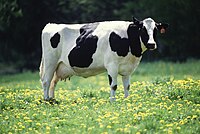
Photo from wikipedia
The objective of this experiment was to compare time to pregnancy and proportion of cows not pregnant 210 d after first service for cows managed for second and subsequent artificial… Click to show full abstract
The objective of this experiment was to compare time to pregnancy and proportion of cows not pregnant 210 d after first service for cows managed for second and subsequent artificial insemination (AI) services with a reproductive management program that promoted reinsemination at detected estrus (AIE) or a program that promoted timed AI (TAI). After first service, lactating Holstein cows were blocked by parity and randomly assigned to d 32 Resynch (D32R; n = 464) or AIE Resynch (AIER; n = 512). To determine the effect of management strategies on time to pregnancy and cows not pregnant by the end of a 210 d at-risk period after first AI service, cows remained in AIER and D32R until pregnancy or herd exit. Cows in D32R received a GnRH treatment 32 ± 3 d after AI (first treatment intervention; FTI). Nonpregnancy diagnosis was conducted 7 d later by transrectal ultrasonography when nonpregnant cows with a corpus luteum (CL) ≥15 mm completed the Resynch protocol (PGF2α, 56 h later GnRH, and 16 to 18 h later TAI) and cows without a CL (NoCL cows) were enrolled in a PreG-Ovsynch protocol (GnRH, 7 d later GnRH, 7 d later PGF2α, 56 h later GnRH, and 16 to 18 h TAI) to receive TAI. For the AIER treatment, nonpregnant cows with a CL ≥15 mm observed by transrectal ultrasonography 32 ± 3 d after AI (i.e., FTI) received PGF2α to induce estrus. Cows not AIE within 7 d were enrolled in Resynch (GnRH, 7 d later PGF2α, 56 h later GnRH, and 16 to 18 h TAI). Cows in the NoCL group in AIER were enrolled in PreG-Ovsynch. Detection of estrus was performed based on visual observation of behavioral signs of estrus and tail-paint removal. Binomial data were analyzed with logistic regression and time to event data with Cox's proportional regression. After the FTI, a greater proportion of cows were AIE in AIER than D32R (36.0 vs. 11.9%) and more cows were AIE within 7 d of the FTI for AIER (25.0%) than D32R (4.8%). Overall pregnancy per AI at 68 ± 3 d after AI did not differ (AIER = 35.5% vs. D32R = 34.7%). The hazard of pregnancy up to 210 d after first AI for all cows enrolled (hazard ratio = 1.04, 95% CI 0.90 to 1.19) and for cows that received treatments only (D32R = 308, AIER = 349; hazard ratio = 1.00, 95% CI 0.85 to 1.19) did not differ. We conclude that a program aimed at increasing the proportion of cows reinseminated at detected estrus by treatment with PGF2α at 32 ± 3 d after AI may be an alternative strategy for dairy farms that prefer or need to inseminate more cows at detected estrus rather than by TAI.
Journal Title: Journal of dairy science
Year Published: 2020
Link to full text (if available)
Share on Social Media: Sign Up to like & get
recommendations!